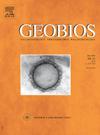舌学损伤混淆了对星鸟下颌骨关节后区域的解释
IF 1.6
4区 地球科学
Q2 PALEONTOLOGY
引用次数: 0
摘要
来自比利时白垩纪晚期的Asteriornis maastrichtensis是已知最古老的冠鸟化石之一,其三维保存的头骨为迄今为止早期冠鸟的颅骨形态提供了最重要的见解。系统发育分析恢复了Asteriornis作为gallanserae的一个整体成员,gallanserae是连接gallanformes和anserformes的分支。支持这种放置的一个重要特征是关节后突的扩大,这在现存的加Galloanserae中形成了下颌骨的长尾延伸。在这里,我们重新解释了Asteriornis的下颚,并说明下颚的近尾部分实际上没有被保存下来。相反,左右下颌支的尾端延伸到包含完整型头骨的化石块的表面,在那里它们被侵蚀掉了。最初发现的右下颌骨关节后突——其形态和方向与某些现存和化石的加龙目动物的关节后突惊人地相似,包括古近纪早期的全进化支变形兽Conflicto和Nettapterornis——相反,它代表了一个扭曲的、尾端移位的内侧突。尽管如此,与现存分类群的解剖比较表明,我们不能排除Asteriornis表现出与现存Galloanserae相似的强健关节后突的可能性。根据对Asteriornis下颌骨形态的重新解释,我们更新了用于研究其系统发育关系的原始解剖特征矩阵,并进行了修订的系统发育分析,这些分析继续支持Asteriornis作为一个整体群的galloanseran,正如最初的解释。我们证明了下颌骨的其他形态学特征支持这一系统发育位置,并为早期冠状鸟的关节后突的性质和分布提供了新的数据。本文章由计算机程序翻译,如有差异,请以英文原文为准。
Taphonomic damage obfuscates interpretation of the retroarticular region of the Asteriornis mandible
Asteriornis maastrichtensis, from the latest Cretaceous of Belgium, is among the oldest known crown bird fossils, and its three-dimensionally preserved skull provides the most substantial insights into the cranial morphology of early crown birds to date. Phylogenetic analyses recovered Asteriornis as a total-group member of Galloanserae, the clade uniting Galliformes and Anseriformes. One important feature supporting this placement was enlargement of the retroarticular processes, which form elongate caudal extensions of the mandible in extant Galloanserae. Here, we reinterpret the jaw of Asteriornis and illustrate that the caudalmost portion of the mandibles are in fact not preserved. Instead, the caudal extremities of both the left and right mandibular rami extend to the surface of the fossil block containing the holotype skull, where they have eroded away. The originally identified retroarticular process of the right mandible – which exhibits a morphology and orientation strikingly similar to the retroarticular processes of certain extant and fossil galloanserans, including the early Palaeogene total-clade anseriforms Conflicto and Nettapterornis – instead represents a twisted and caudally displaced medial process. Nonetheless, anatomical comparisons with extant taxa reveal that we cannot exclude the possibility that Asteriornis exhibited robust retroarticular processes comparable to those of extant Galloanserae. In light of the reinterpreted morphology of the Asteriornis mandible, we update the original anatomical character matrix used to investigate its phylogenetic relationships and perform revised phylogenetic analyses, which continue to support Asteriornis as a total-group galloanseran, as initially interpreted. We demonstrate additional morphological traits of the mandible supporting this phylogenetic position and provide new data on the nature and distribution of retroarticular processes among early crown birds.
求助全文
通过发布文献求助,成功后即可免费获取论文全文。
去求助
来源期刊

Geobios
地学-古生物学
CiteScore
3.30
自引率
6.20%
发文量
28
审稿时长
6-12 weeks
期刊介绍:
Geobios publishes bimonthly in English original peer-reviewed articles of international interest in any area of paleontology, paleobiology, paleoecology, paleobiogeography, (bio)stratigraphy and biogeochemistry. All taxonomic groups are treated, including microfossils, invertebrates, plants, vertebrates and ichnofossils.
Geobios welcomes descriptive papers based on original material (e.g. large Systematic Paleontology works), as well as more analytically and/or methodologically oriented papers, provided they offer strong and significant biochronological/biostratigraphical, paleobiogeographical, paleobiological and/or phylogenetic new insights and perspectices. A high priority level is given to synchronic and/or diachronic studies based on multi- or inter-disciplinary approaches mixing various fields of Earth and Life Sciences. Works based on extant data are also considered, provided they offer significant insights into geological-time studies.
 求助内容:
求助内容: 应助结果提醒方式:
应助结果提醒方式:


